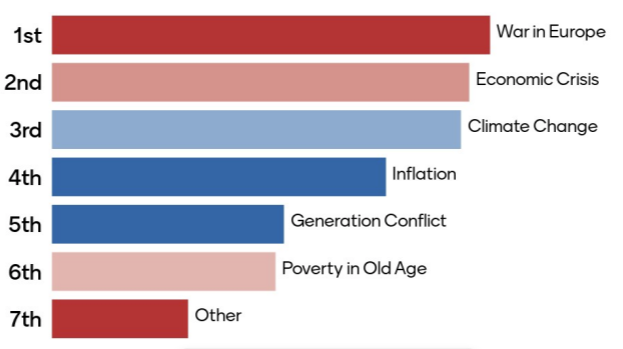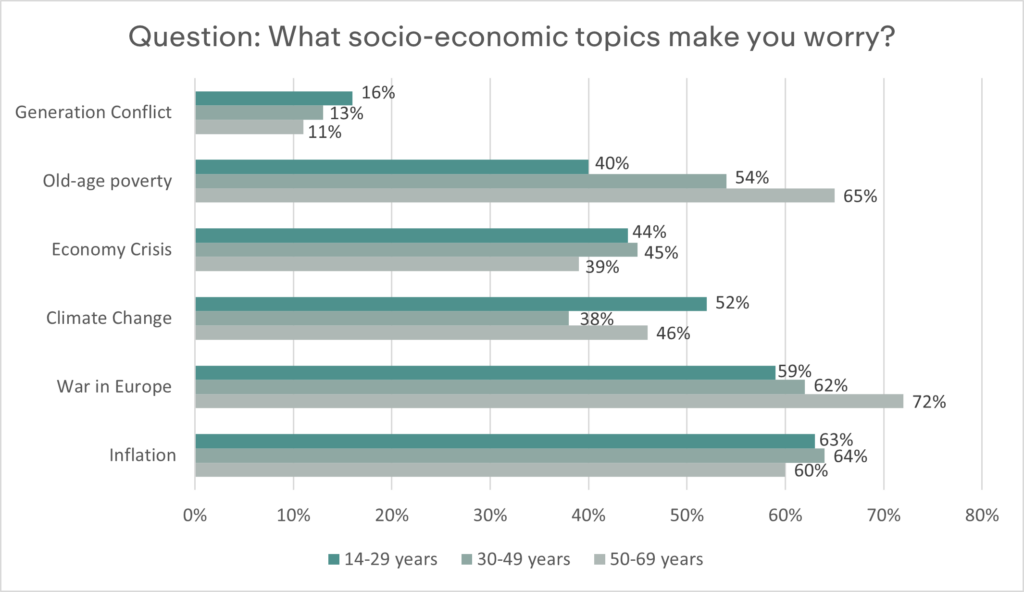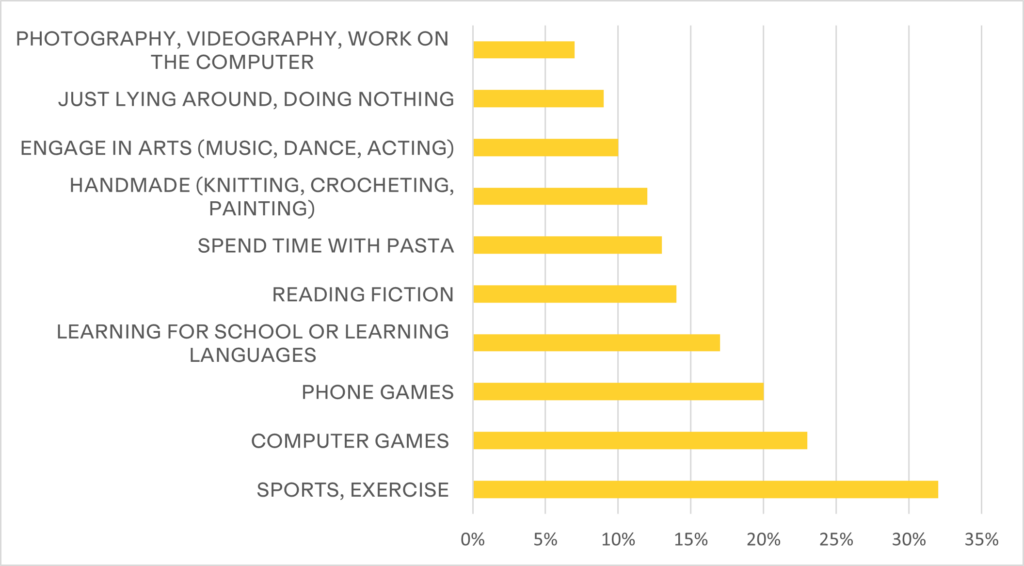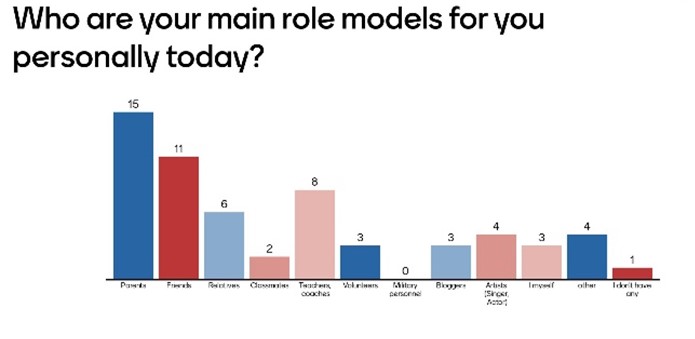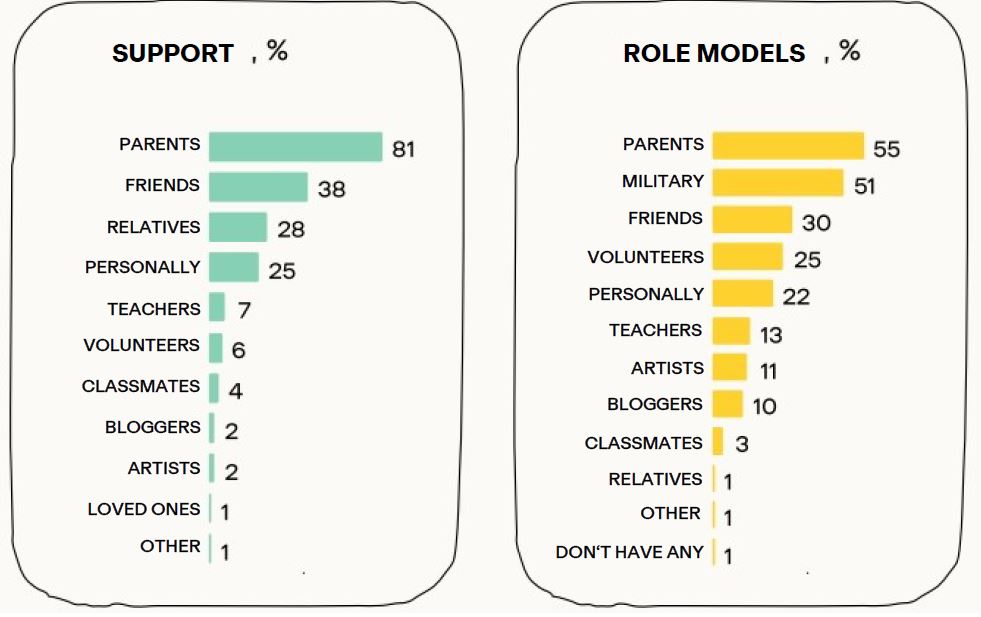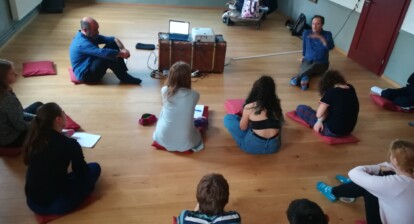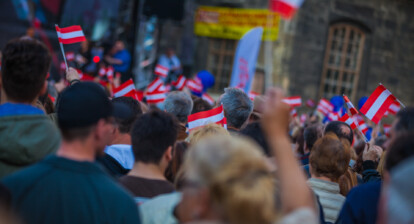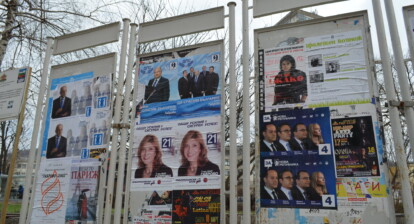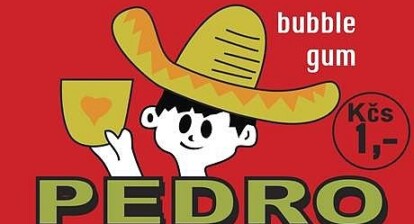Traveling to Prague for the EUSTORY Next Generation Summit? Exciting! To do so as a teamer? At least as exciting! Delve in the experiences our Summit team member and EUSTORY alumna Vida made when talking to Europe’s youth in Prague.
Dialogues I remember
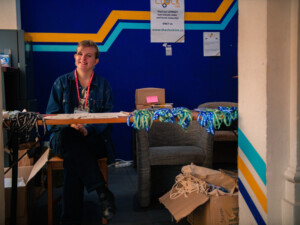
Vida at the Summit reception desk (Photo: Körber-Stiftung).
“Vida! Wooow, you look so serious!”, my friend Luigi greeted me after a long time. We met four years ago, when I attended the Next Generation Summit 2019 in Berlin as a participant. It was an unforgettable experience, and I was motivated to shape this year’s Summit as a teamer. Hugging each other, Luigi made fun of me as he had never seen me in such a serious function at a reception desk before. This heartwarming encounter marked the perfect start of the EUSTORY Summit 2023 for me. I knew my old friends were going to attend this international youth history festival together with 100 young enthusiasts from all over Europe. I was happy to welcome them after their long journeys from 23 countries.
In the Middle of the Tower of Babel
I introduced myself in French to someone, I could explain the check-in process in Russian, and I heard lively conversations that were conducted in Hebrew between two Israeli and one German participant. I was curious to know what everybody was talking about in our small self-curated tower of Babel.
One participant from Germany shared: “I had discussions about feminism, the war in Ukraine, economic inequality which went far beyond my topic of the workshop but evolved naturally because I could connect with people who are as involved, engaged and curious as I am.”
After three years shaped by uncertainty, social and political divide and a global pandemic, I was happy to meet such motivated and open-minded young people on the very first Summit day. However, I couldn’t stop asking myself: Which traces did the crises and wars in Europe leave? I was curious to find out what worries and fears would preoccupy participants in the back of their minds.
A Self-Made Youth Study
To find out, I meticulously crafted an in-house survey, the EUSTORY Pulse Check, inspired by other major European Youth Studies. While this survey is a uniquely self-made endeavor, it stands on the shoulders of representative studies from Ukraine, Germany and 7 European countries.
What socio-economic topics make you worry?
- EUSTORY Summit Survey Results
- Trend Study from Germany (Source: Simon Schnetzer)
Was poverty in old age a worry, or did young people worry about climate change the most? On the right side you see the results of a trend study conducted in Germany: Young German people seem especially worried about inflation (63%), followed by war in Europe (59%) and climate change (52%). On the left side however, one can see that war in Europe is the number-1 worry of EUSTORY Summit participants (representing 23 countries), followed by the economic crisis. There are definite parallels with regard to the biggest three worries, however, why is Germany’s youth less worried about the war than Europe’s average is? I can only explain it by the privileged position we as young Germans – in political, but also geographical terms – find ourselves in compared to young people living in less stable conditions. Many of the asked Summit participants came from Eastern European countries.
Midnights Walks and a Fierce Competition

In good spirits after the Table Football Tournament: Tomer, Vida, Sophia (Photo: private)
While it’s evident that these worries weigh heavily on our minds, it’s also essential for us to take breaks, recharge and find moments of smiles. Speaking of lighthearted distractions, we had a great number of activities during the EUSTORY Summit that I enjoyed participating in. Having midnight walks in the city of Prague, funny conversations and encouraging words raised my spirits during the Summit. We also held a table football tournament where I teamed up with a good friend of mine. However, Tomer from Israel and I were kicked out after the first round with a close score of 9:10. As these activities were very entertaining to reset my mind for the next day, I wanted to know from the Summit participants:
What helps you distract yourself from fears, bad news and worries?
- Results from the EUSTORY Survey
- Results from a Ukranian Youth Survey
How Does Europe’s Youth Relax?
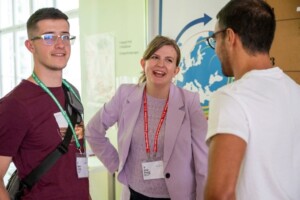
Light-hearted banter in-between workshops: Rigers, Vida and Luigi (Photo: David Kumermann)
This question has already been posed by a Ukrainian youth study, asking teenagers living in Ukraine how they perceived the challenges their country faced related to the pandemic and the ongoing war. Comparing the results from Ukraine with the ones collected during the EUSTORY Summit, one can observe that Ukrainian teenagers show a remarkable level of activity compared to their EUSTORY counterparts. Most of the 100 asked Summit participants find solace in moments of quiet reflection by lying around and choose to unwind by simply resting, though engaging in arts and reading books. At the same time, Ukrainian teens tend to gravitate towards activities that keep their body (sports, exercise) and minds (computer games, learning languages) engaged. Only 9% of Ukrainian respondents would do nothing to unwind from life’s stresses.
This difference in behavior could be connected to how safe or uncertain young people feel in their respective countries. Since their home country is being attacked by Russian forces, Ukrainians have faced incredible fears, experienced losses – be it of family members, friends, their homes or at least the feeling of being secure – , and this might make them lean more towards staying active as a way to distract themselves. Meanwhile, European young people might find comfort in downtime since they live in more stable environments.
Role Models of Europe’s Youth
During the pandemic I had started knitting on a pullover, as I admire my mother’s handcrafty skills. During the Summit, I also rediscovered new role models among good friends who brought much joy, humor and some wisdom into my life. On that note, I wondered who are the people that have played a pivotal role in shaping participants’ interests and aspirations? I was looking up to my friends, colleagues, and parents the most. But was everybody sharing this sentiment?
Who are your main role models?
- The role models of EUSTORY Summit participants
- Role models for young Ukrainians (Source: Dobrodiy Club)
Most Summit participants, 41% respondents aged 16 to 25 to be precise, see their parents as role models, a sentiment that mirrors the findings of the Ukrainian study where a majority of teens (55%) also looks up to their parents. Are we less independent from our parents than we think? Well, I leave this up to you!
Unexpected Trends in Ukraine and Beyond
However, Ukrainian teenagers show a notably distinctive trend: While parents are the number 1 role models for them as well, the military takes 2nd place as a role model. A finding that starkly contrasts with the results of the EUSTORY Summit survey, in which nobody named military personnel as a role model. Does our Summit reflect a more pacifist outlook? I don’t think that young Ukrainians are less pacifist at all. Since the Russian attack that was followed by the proclamation of martial law in Ukraine, they experience the fears and consequences of war every day. Male friends and family members aged 18 or older are not allowed to leave the country and can be called up to serve the army and to defend their country. So it is hardly surprising that the military is taking on a different role than in other European countries.
A Glimmer of Hope

Goodbyes and farewells (Photo: David Kumermann)
A glimmer of hope: a shadow theatre that young participants with Russian roots presented on the last evening. Living in Latvia, Germany, France, Georgia and other countries, they were participating in an external workshop organised by Zukunft Memorial e.V. Their focus lied on forced migration in the 20th century. The participants used a dark room with only a projector and some pieces of paper to visualise stories of escape and exile. The biographies they referred to in their theatre play cmae from the family history of an Armenian workshop participant and a Czech contemporary witness they had interviewed in Prague.This performance was an optional offer to Summit participants and it was great to see that many young Europeans and even two Ukrainians joined to see the special theatre play.
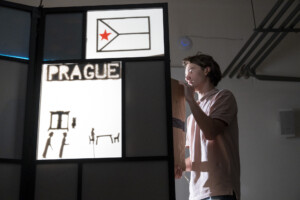
The Shadow Theater Presentation (Photo: David Kumermann)
Last Reflections
Sadly, the few days after the Summit were overshadowed by the outbreak of another war: The terrorist organisation Hamas had attacked Israel and kidnapped hundreds of hostages to Gaza – a horrifying event, first and foremost to the four Summit participants from Israel. And also the Armenian Summit participants knew they would return to a sphere of violent tensions that were ongoing in Artsakh near Armenia. After my return to Hamburg, where the EUSTORY International Office is located, I could hopefully bring glimpses of solace to our participants by sending the postcards away which the participants had written for each other in Prague. In hope that these postcards could lighten their spirits, I carefully adressed these letters to each individual receiver.
And how about the survey? Fears around war in Europe were confirmed and will probably last until there’s peace. At the same time, I hope that the new inspirations to keep engaging in arts and the love for new encounters will last much longer for the participants. With this event, we did our best to bring awareness to history as a tool for peace and reconciliation.
A heartfelt thank you to all participants who took part in our EUSTORY Pulse Check, and a special thanks to everyone I could meet and work with. It was a pleasure!
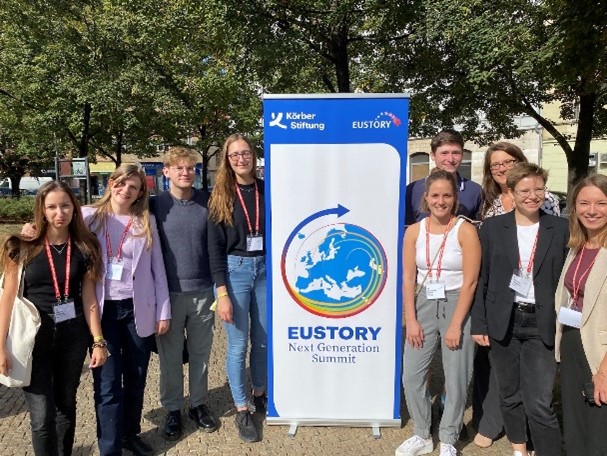
Our EUSTORY Summit Team 2023 (Photo: Körber-Stiftung)


